

You can thank wasps for your bread, beer and wine. If wasps didn’t exist, picnics would be a lot more fun.

But the next time you find yourself trying to dodge a flying, jam-seeking harpoon, think about this: without wasps, many of your ingredients might not exist at all. Irene Stefanini and Leonardo Dapporto from the University of Florence have found that the guts of wasps provide a safe winter refuge for yeast – specifically Saccharomyces cerevisiae, the fungus we use to make wine, beer and bread. And without those, picnics would be a lot less fun.
S.cerevisiase has been our companion for at least 9,000 years, not just as a tool of baking and brewing, but as a doyen of modern genetics. It has helped us to make tremendous scientific progress and drink ourselves into stupors, possibly at the same time. The wild strains do grow on grapes and berries, but only found on ripe fruits rather than pristine ones. Breathtaking Shots of Millions of Flamingos. Where do you go to see the greatest bird spectacle on earth?

The Kenya Lake System in the Great Rift Valley. Come at the right time and you'll see the shoreline of Kenya's lakes turn bright pink as they're filled with millions of flamingos. The lesser flamingos (the smallest species of them) gather at these lakes to feed on the abundant blue-green algae which thrive in the warm alkaline waters. UNESCO calls it " the single most important foraging site for the lesser flamingo anywhere. " Professional wildlife photographer Martin Harvey was lucky enough to see this for himself, coming back with these amazing photos. Dead whale found in Portsmouth Harbour - News. Does your child have what it takes to win Baby and Toddler of the year 2012? News Local Portsmouth Gosport. Baby bats rescued from hot loft in Taunton. 31 July 2012Last updated at 11:09 ET The baby bats are being hand-weaned with a milk substitute to help them recover from their ordeal A group of baby bats is recovering at a Somerset wildlife centre having fled from a hot loft in a house in Taunton.
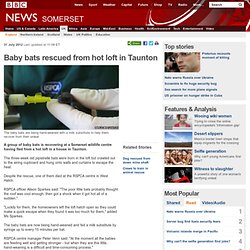
The three-week old pipistrelle bats were born in the loft but crawled out to the airing cupboard and hung onto walls and curtains to escape the heat. Despite the rescue, one of them died at the RSPCA centre in West Hatch. RSPCA officer Alison Sparkes said: "The poor little bats probably thought the roof was cool enough, then got a shock when it got hot all of a sudden. " "Luckily for them, the homeowners left the loft hatch open so they could make a quick escape when they found it was too much for them," added Ms Sparkes. The baby bats are now being hand-weaned and fed a milk substitute by syringe up to every 15 minutes per bat. BBC Nature - In pictures: Giant helicopter damselfies.
Wild Quaker Parrots in Miami Florida. Not so free as a bird: Provocative pictures show species tangled up in ornithologists' mist nets. By Daily Mail Reporter Published: 00:28 GMT, 1 August 2012 | Updated: 07:27 GMT, 1 August 2012 Snarled up in nets, their freedom snatched away, these stunning birds cut a sorry sight.
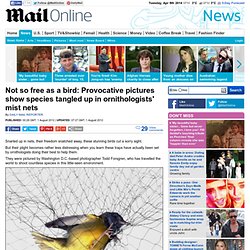
The Grumpy Ecologist: Crakey! Change the record books. Calling Baillon's in typically rushy habitat.

Last year, during a trip to The Netherlands, we speculated that Baillon’s Crake was being overlooked in the UK, both as a migrant and breeding bird. With fortuitous timing, a national Spotted Crake survey has been undertaken this year and surveyors were asked to listen out for Baillon’s Crake. And one was found! Ontario couple finds honey, 80,000 bees in ceiling - Toronto. Never mind a house of horrors, this was a house of honey.
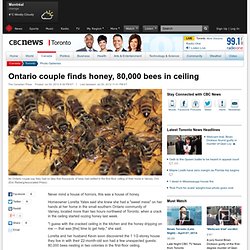
Homeowner Loretta Yates said she knew she had a "sweet mess" on her hands at her home in the small southern Ontario community of Varney, located more than two hours northwest of Toronto, when a crack in the ceiling started oozing honey last week. "I guess with the cracked ceiling in the kitchen and the honey dripping on me — that was [the] time to get help," she said. Bats 'starving' after wet weather, Sussex Wildlife Trust says. 31 July 2012Last updated at 08:56 ET The pipistrelle, Britain's smallest native bat and its most common, eats up to 3,000 midges and gnats every night.
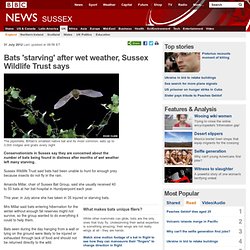
New flu virus found in seals concerns scientists. 31 July 2012Last updated at 02:57 ET By Matt McGrath Science reporter, BBC World Service Harbour seals in New England were found to be infected with the new strain Scientists in the United States have identified a new strain of influenza in harbour seals that could potentially impact human and animal health.
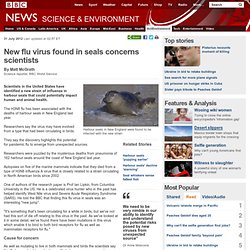
The H3N8 flu has been associated with the deaths of harbour seals in New England last year. BBC Nature - Operation Iceberg diary: The camp fox. 31 July 2012Last updated at 02:06 By Chris Packham Operation Iceberg Coat of many colours: Arctic foxes turn bright white in the icy winter "Operation Iceberg" is a five-week mission for our team of scientists and filmmakers to document the life-cycle of Arctic icebergs from their birth to death, hoping to reveal their secrets in a BBC/Discovery Channel co-production.

This is the third of my BBC Nature diaries, detailing my experience of sharing our temporary home with arctic foxes. Great Egret for Monday. Great Egret for Monday Yesterday while birding Dead Creek in Vermont, I finally got close enough for halfway decent shots of the Great Egret.

I had fun watching him sneak and stalk small fish and catch a few too. I have mentioned many dragonflies over the last week, and I do have some decent shots, just having a heck of a time getting their ID’s. Northumberland river survey identifies habitat problems. 29 July 2012Last updated at 06:23 ET Improvements to river bank vegetation could help birds including the dipper Northumberland rivers are failing water quality tests because of obstructions and a lack of riverbank vegetation, a survey has shown.
The survey was commissioned after the Rivers Blyth and Lyne failed the European Union's Water Framework Directive (WFD) for water quality. Northumberland Wildlife Trust (NWT) is using a £70,000 grant to improve the two water courses. The report also shows increased river bed silt is affecting fish egg-laying. The Wild Trout Trust conducted the survey for the NWT. Steve Lowe, head of conservation at Northumberland Wildlife Trust said: "We will be meeting with land managers, angling clubs and community groups, to agree a priority action plan which will include tree planting to create bankside cover, fencing works to reduce siltation from stock, removal of structures and a wide programme to increase diversity in the rivers.
" Dramatic deer rescue in Uckfield. World's Weirdest - "Missile" Birds. Animal pictures of the week: 27 July 2012. Summer's here but too late for swifts. Print page Last modified: 26 July 2012 Warmer, drier weather has arrived too late to help most Swifts this year - one of our most iconic summer birds. Flocks of swifts are beginning to be seen heading back to Africa following a ‘disastrous’ cold and wet breeding season. The birds are already on the amber-list of conservation concern after declining by 31per cent between 1995 and 2009. The cold and wet spring and summer months this year have meant fewer flying insects for them and their chicks to feed on. Elusive, Threatened Gopher Tortoise Spotted Laying Eggs in Alabama. Gopher tortoise laying eggs on freshly cultivated field. Gopher tortoises are fairly elusive creatures. Usually the only sign you see of them is their burrows or ravaged foliage.
Breathtaking Photos of Deep Sea Creatures by Mark Laita. Whale skull found to be at least 300 years old, will find new home at Smithsonian - Metro. Germaine Greer: Snails deserve our attention. When I gathered a small tub of our native mahogany and cream snails (two species, Cepaea nemoralis and C. hortensis) and took them into the house to see if I could key them out properly, they motored all over their plastic container, utterly optimistic and trusting. When they extended their delicate antennae and stretched their translucent bodies to travel over my hand, I couldn’t imagine smashing them or poisoning them, no matter how many hostas they ate.
Snails are deaf, so you can’t train them to carry out orders; but they are capable of associative thinking. They can remember where things are; they know where they sleep; Darwin noticed how one snail discovered how to escape from a tank, and returned the next night to help another snail escape by the same route. Burrowing Owls – Most of the Family. By Mia McPherson, on July 28th, 2012. Britain’s fastest and oldest birds are revealed. Only one species, the goldcrest (Regulus regulus) – which is the UK’s smallest bird – appears twice in the top ten, with both making rapid journeys across the North Sea to the Yorkshire coast, one arriving from Denmark, at an average speed of 19mph, and the other from Norway, at 16mph. BBC Nature - Net-casting spider hunt filmed in wild. BBC Nature - Frogs rescued from killer fungus have 'massive' brood. The eagle has landed... Charter House's first tenant causes flap. By James Scott. The Big Bat Map.
London's amphibians and reptile populations mapped. From smooth newts living by the Tate Modern to common frogs across London, amphibians are widespread in the capital, but snakes and other reptiles are largely confined to its outer rings, the first map of the city's amphibian and reptile populations shows. The map shows London's native amphibians - common frogs, common toads, smooth newts, palmate newts and great crested newts - to be relatively populous across the city, while native reptiles - slow-worms, common lizards, grass snake and adder - are far more sparse, confined mainly to the outer boroughs. Hummingbird Moth And Summer Colors. ‘Spiders Alive!’ at American Museum of Natural History.
The Darker Side of Elephant Country. 'First' 50-eyed flatworm discovered in Cambridgeshire. 21 July 2012Last updated at 09:12 ET The flatworm could be a new species, experts believe A tiny flatworm with between 50 and 60 eyes, discovered on a Cambridgeshire nature reserve, is believed to be a new species. BBC Nature - Great bustard videos, news and facts. BBC Nature - Big horned rhinoceros beetles are healthiest. 26 July 2012Last updated at 19:12 By Ella Davies Reporter, BBC Nature. Seeking Relief for Coral Reefs. Facing new threats from climate change, corals get help from scientists who study the organisms’ complex biology. Termites' crystal backpacks help them go out with bang. Five geese will be shot as residents in upmarket street complain about 'packets of nuisance' being trodden into their homes. Rainforest wildlife havens on brink of collapse - Nature - Environment.
More 'animals on ice' Baby deer has lots of bottle. Glasgow's 'first' Peregrine chick raised in Red Road flats. Wet weather sparks concern for swifts, RSPB says. BBC Nature - Australasian tree frogs videos, news and facts. Malta's only Peregrines shot by hunters. Species number on Earth a mystery. Lioness battles deadly crocodile to clear the way for her family to cross. Metro.co.uk: News, sport, showbiz, celebrities from Metro newspaper. Summer arrives ... and so does Flying Ant Day! But before you run back indoors, experts urge you to help count the swarms. Nile monitor lizard loose in Colorado mountains. Schoolgirls use bees to fight rhino poachers. Walker catches boa constrictor on Austrian riverbank. Gloucestershire drivers on wallaby watch. In pictures: Edinburgh Zoo’s latest arrival in love at first swipe - Pictures. BBC Nature - Two-toed sloths' 'lazy' sex life revealed. Small, but perfectly formed: Breeding programme success as group of tiny seahorses born in Bournemouth aquarium.
Giant otter Akuri set to swap Hampshire for Trinidad. The week in wildlife - in pictures. Starlings in danger after numbers plummet 80p per cent. Who dares the rain will get puffins. Lucy Cooke: 10 Freaky Animals You Have to See to Believe. Can Heavily Deforested Sebangau National Park Be Saved? Six Hundred Unknown Species Discovered in Madagascar. First known NZ whale birth since end of hunting. Longleat Safari Park macaque monkey captured with fruit trap. Top 10 Wildlife Photography Tips. Nature's Microworlds. New scarlet snake found in Cambodia. Coast Guard Assists Sea Turtle off Montauk. Are you my mum? An endangered spoon-billed sandpiper chick explores its new home after fraught trip from Russia to join UK conservation project. Endangered snow leopard habitat threatened by climate change, WWF study shows. Bees Intelligence Witnessed in the Wildlife Garden. Nservationists call for public inquiry into pearl mussel decline. Rare one-in-a-million white sparrow is captured on camera in Scotland.
Rare pictures emerge of a snow leopard with her cub. 13 Amazing Photos of Freshwater Creatures Invisible to the Naked Eye. Brown hare and quail at Elmley Marshes @ UK Wildlife.